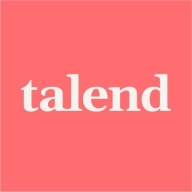

Talend Open Studio and Palantir Foundry compete in data integration and management, with Talend appealing to small to mid-sized businesses due to its open-source model and lower costs, while Palantir Foundry attracts larger enterprises through its advanced features and scalability.
Features: Talend Open Studio is known for its ease of use, versatility, and extensive integration capabilities aided by a large set of components. It offers robust ETL functionalities and a scalable Java-based platform with simple drag-and-drop mechanics. On the other hand, Palantir Foundry is preferred for its powerful data visualization and integration through strong API features, making it highly beneficial for end-to-end data solutions. Its unique front-end capabilities offer more than traditional tools, which is appealing for complex data needs in large enterprises.
Room for Improvement: Talend Open Studio is limited by the advanced features available only in paid versions, and users report challenges with installation and optimizing Java applications. Absence of parallel execution is another drawback. Meanwhile, Palantir Foundry faces high initial costs and setup complexities, along with a need for better frontend functionalities and automation tools. Users have also reported issues with error messaging and documentation.
Ease of Deployment and Customer Service: Talend Open Studio provides flexibility across on-premises and hybrid cloud deployments, helping it integrate into varied IT environments. However, deployment can be complex, and customer service is mostly reliant on community forums due to the open-source nature. Palantir Foundry is focused on public cloud deployments, supported by comprehensive integration services that justify its higher cost, though customer service could improve, with some users noting slower responses.
Pricing and ROI: Talend Open Studio's cost-efficiency is highlighted by its open-source model, making it ideal for budget-conscious businesses, delivering satisfactory ROI without significant expenses. Conversely, Palantir Foundry's high cost is balanced by reduced dependence on additional development, offering extensive capabilities that drive significant ROI for larger enterprises due to its comprehensive toolset.
| Product | Market Share (%) |
|---|---|
| Talend Open Studio | 3.2% |
| Palantir Foundry | 3.1% |
| Other | 93.7% |


| Company Size | Count |
|---|---|
| Small Business | 4 |
| Midsize Enterprise | 5 |
| Large Enterprise | 8 |
| Company Size | Count |
|---|---|
| Small Business | 22 |
| Midsize Enterprise | 13 |
| Large Enterprise | 18 |
Palantir Foundry is an enterprise data management platform offering comprehensive tooling for working with big data. Because it is an operating system made for modern enterprises, it is highly available and a continuously updated platform.
Palantir Foundry is a fully managed SaaS platform that spans from cloud hosting and data integration to flexible analytics, visualization, model-building, operational decision-making, and decision capture. It equips technical and non-technical users to make data-driven operational decisions.
Palantir Foundry includes tools to integrate data of any scale, format, or structure, and also has granular, flexible access controls for individual datasets. In addition, it has an open, modular architecture with multiple RESTful APIs, it has native applications for developing machine learning and artificial intelligence, it provides sophisticated data science applications for users of all technical abilities, and much more.
Palantir Foundry Features
The most valuable Palantir Foundry features include:
Security, flexibility, interoperability, easy deployment, built-in role classification, purpose-based access controls, interoperable architecture, model integration, AI modeling tools, ontology, custom workflows, team-specific applications, self-serve analytics, lineage system, operational application building, 200+ data connectors, data versioning, change management framework, sand decision orchestration, and custom dashboard and report building tools.
With Palantir Foundry You Can:
Palantir Foundry Benefits
Some of the many Palantir Foundry benefits include:
Reviews from Real Users
PeerSpot users like Palantir Foundry because it has many advantages:
“It is user-friendly, good automation, and allows you to do a better job of data governance.” - Associate, Inhouse Consulting at a pharma/biotech company
“Works seamlessly with good end-to-end capabilities and the capability to scale.” - Wallace H., Sr. Director at a tech services company
Talend Open Studio is a free, open source ETL tool for data integration and Big Data. The solution enables you to extract diverse datasets and normalize and transform them into a consistent format which can be loaded into a number of third-party databases and applications.
Talend Open Studio Features
Talend Open Studio has many valuable key features. Some of the most useful ones include:
Talend Open Studio Benefits
There are several benefits to implementing Talend Open Studio. Some of the biggest advantages the solution offers include:
Reviews from Real Users
Below are some reviews and helpful feedback written by PeerSpot users currently using the Talend Open Studio solution.
Elio B., Data Integration Specialist/CTO at Asset messages, says, "The solution has a good balance between automated items and the ability for a developer to integrate and extend what he needs. Other competing tools do not offer the same grade of flexibility when you need to go beyond what is provided by the tool. Talend, on the other hand, allows you to expand very easily."
A Practice Head, Analytics at a tech services company mentions, “The data integration aspect of the solution is excellent. The product's data preparation features are very good. There's very useful data stewardship within the product. From a technical standpoint, the solution itself is pretty good. There are very good pre-built connectors in Talend, which is good for many clients or businesses, as, in most cases, companies are dealing with multiple data sources from multiple technologies. That is where a tool like Talend is extremely helpful.”
Prerna T., Senior System Executive at a tech services company, comments, “The best thing I have found with Talend Open Studio is their major support for the lookups. With Salesforce, when we want to relate our child objects to their parent object, we need to create them via IDs. Then the upsert operation, which will allow you to relate a child object to the event, will have an external ID. That is the best thing which keeps it very sorted. I like that.”
An Implementation Specialist, Individual Contributor at a computer software company, states, “I can connect with different databases such as Oracle Database or SQL Server. It allows you to extract the data from one database to another. I can structure the data by filtering and mapping the fields.” He also adds, “It is very user-friendly. You need to know the basics of SQL development or SQL queries, and you can use this tool.”
PeerSpot user Badrakh V., Information System Architect at Astvision, explains, "The most valuable features are the ETL tools."
We monitor all Data Integration reviews to prevent fraudulent reviews and keep review quality high. We do not post reviews by company employees or direct competitors. We validate each review for authenticity via cross-reference with LinkedIn, and personal follow-up with the reviewer when necessary.